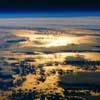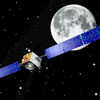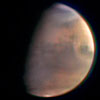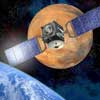|
Sunday:
December 7, 2003 | |
0001 GMT |
 |
Mapping the atmosphere
NASA scientists have opened a new window for understanding atmospheric water vapor, its implications for climate change and ozone depletion. They have created the first detailed map of the atmosphere to better understand the dynamics of how water gets into the stratosphere.
 FULL STORY FULL STORY
 |  |

|
 |
SMART-1 is changing ion engine thrust strategy
Europe's SMART-1 spacecraft is now in its 130th orbit, in good status and all its functions are performing nominally. As in previous weeks, the spacecraft was operated in electric propulsion mode almost continuously. However, it has experienced three flame-outs.
 FULL STORY FULL STORY
 |  |

|
 |
|
Saturday:
December 6, 2003 | |
0712 GMT |
 |
NASA scientists use radar to detect asteroid force
NASA scientists have for the first time detected a tiny but theoretically important force acting on asteroids by measuring an extremely subtle change in a near-Earth asteroid's orbital path. This force, called the Yarkovsky Effect, is produced by the way an asteroid absorbs energy from the sun and re-radiates it into space as heat. The research will impact how scientists understand and track asteroids in the future.
 FULL STORY FULL STORY
 |  |

|
 |
International Space Station crew busy with science
The Expedition 8 -- Mike Foale and Alexander Kaleri -- have wrapped up a busy week aboard the International Space Station. ISS activities included scientific experiments ranging from behavior of plasma dust subjected to radio waves in a vacuum to investigation of stresses on the feet and legs during spaceflight.
 FULL STORY FULL STORY
 |  |

|
 |

Video coverage for subscribers only:
 VIDEO: WATCH FRIDAY'S STATION STATUS NEWS CONFERENCE QT VIDEO: WATCH FRIDAY'S STATION STATUS NEWS CONFERENCE QT
 MORE VIDEO AVAILABLE! MORE VIDEO AVAILABLE!
 SUBSCRIBE NOW SUBSCRIBE NOW

|
|
Friday:
December 5, 2003 | |
0525 GMT |
 |
No new space policy announcement imminent
White House officials Thursday denied reports that President Bush planned to announce soon a new space policy that could feature the resumption of human missions to the Moon.
 FULL STORY FULL STORY
 |  |

|
 |
Atlas launch pad getting extensive facelift
A pad at America's West Coast spaceport, Vandenberg Air Force Base in California, will soon receive a major makeover to transform the complex into a launch site for Lockheed Martin's next-generation Atlas 5 rocket.
 FULL STORY FULL STORY
 OUR ARCHIVE OF ATLAS COVERAGE OUR ARCHIVE OF ATLAS COVERAGE
 |  |

|
 |
Firestorm of star birth seen in a local galaxy
This festively colorful nebula, called NGC 604, is one of the largest known seething cauldrons of star birth in a nearby galaxy. NGC 604 is similar to familiar star-birth regions in our Milky Way galaxy, such as the Orion Nebula, but it is vastly larger in extent and contains many more recently formed stars.
 FULL STORY FULL STORY
 |  |

|
 |
NASA cites progress in earthquake research
Nearly 10 years after Los Angeles was shaken by the devastating, magnitude 6.7 Northridge earthquake, scientists at NASA and other institutions say maturing space-based technologies, new ground-based techniques and more complex computer models are rapidly advancing our understanding of earthquakes and earthquake processes.
 FULL STORY FULL STORY
 |  |

|
 |

Video coverage for subscribers only:
 VIDEO: WATCH NEWS CONFERENCE ON EARTHQUAKE RESEARCH QT VIDEO: WATCH NEWS CONFERENCE ON EARTHQUAKE RESEARCH QT
 MORE VIDEO AVAILABLE! MORE VIDEO AVAILABLE!
 SUBSCRIBE NOW SUBSCRIBE NOW

|
|
Thursday:
December 4, 2003 | |
0608 GMT |
 |
Observers track secret satellites launched Tuesday
Serving as space-age sleuths tracking spy satellites high above Earth, a band of sky-watchers scattered around the globe are offering their insights into a clandestine cargo launched Tuesday atop an Atlas rocket from California.
 FULL STORY FULL STORY
 |  |

|
 |
Stormy space weather slips through cracks
Immense cracks in Earth's magnetic field remain open for hours, allowing the solar wind to gush through and power stormy space weather, according to new observations from NASA and European satellites. This new discovery about how the Earth's magnetic shield is breached is expected
to help space physicists give better estimates of the effects of severe space weather.
 FULL STORY FULL STORY
 |  |

|
 |

Video coverage for subscribers only:
 VIDEO: WATCH NEWS CONFERENCE ON THE NEW FINDINGS QT VIDEO: WATCH NEWS CONFERENCE ON THE NEW FINDINGS QT
 SUBSCRIBE NOW SUBSCRIBE NOW

|
Pulsar find boosts hope for gravity-wave hunters
Neutron star pairs may merge and give off a burst of gravity waves about six times more often than previously thought, scientists report in the new issue of the journal Nature. If so, the current generation of gravity-wave detectors might be able to register such an event every year or two, rather than about once a decade - the most optimistic prediction until now.
 FULL STORY FULL STORY
 |  |

|
 |
|
Wednesday:
December 3, 2003 | |
2015 GMT |
 |
Mars Express snaps its first view of Red Planet
The European Space Agency's Mars Express spacecraft has taken image of its destination from a distance of about 5.5 million kilometres. This is a very unusual view of Mars because the planet is illuminated in a way never seen from Earth. Mars Express arrives in orbit around the Red Planet on Christmas Day.
 FULL STORY FULL STORY
 |  |

|
 |
NASA comet craft pinpoints its target
Forty-nine days before its historic rendezvous with a comet, NASA's Stardust spacecraft successfully photographed its quarry, comet Wild 2, from 15.5 million miles away. The image, the first of many comet portraits it will take over the next four weeks, will aid Stardust's navigators and scientists as they plot their final trajectory toward a January flyby and collection of samples from Wild 2.
 FULL STORY FULL STORY
 |  |

|
 |
Lindsey to lead crew of new space shuttle mission
Four NASA astronauts have been chosen to fly on the newly created space shuttle mission, STS-121. It is the mission following the shuttle's return-to-flight.
 FULL STORY FULL STORY
 |  |

|
 |
SNOE satellite to re-enter atmosphere in coming days
A $5 million University of Colorado at Boulder satellite dubbed the "Little Satellite That Did" now is expected to re-enter the atmosphere and burn up in early December following a successful six-year mission.
 FULL STORY FULL STORY
 |  |

|
 |
|
Tuesday:
December 2, 2003 | |
1215 GMT |
 |
Atlas rocket successfully soars on secret mission
A Lockheed Martin Atlas 2AS rocket carried out a clandestine mission in the predawn darkness Tuesday, deploying into space what is believed to be a package of ocean surveillance satellites to aid the U.S. government track suspicious ships in the global fight against terrorism.
 FULL STORY FULL STORY
 MISSION STATUS CENTER MISSION STATUS CENTER
 GROUND TRACK MAP GROUND TRACK MAP
 RL10 ENGINE MARKS 40 YEARS OF SERVICE RL10 ENGINE MARKS 40 YEARS OF SERVICE
 |  |

|
 |

Video coverage for subscribers only:
 VIDEO: ATLAS ROCKET LIFTS OFF THIS MORNING AS SEEN LIVE QT VIDEO: ATLAS ROCKET LIFTS OFF THIS MORNING AS SEEN LIVE QT
 VIDEO: REPLAY OF LAUNCH WITH NATURAL SOUND OF IGNITION QT VIDEO: REPLAY OF LAUNCH WITH NATURAL SOUND OF IGNITION QT
 VIDEO: CLOSE VIEW OF SLC-3E PAD AS ATLAS LIFTS OFF QT VIDEO: CLOSE VIEW OF SLC-3E PAD AS ATLAS LIFTS OFF QT
 VIDEO: ANOTHER VIEW SHOWS ROCKET'S ASCENT INTO NIGHT SKY QT VIDEO: ANOTHER VIEW SHOWS ROCKET'S ASCENT INTO NIGHT SKY QT
 SUBSCRIBE NOW SUBSCRIBE NOW

|
New evidence for nearby Solar-like planetary system
Astronomers have produced compelling new evidence that Vega, one of the brightest stars in the sky, has a planetary system around it which is more like our own Solar System than any other so far discovered.
 FULL STORY FULL STORY
 |  |

|
 |
SOHO Sun watcher celebrates 8 years in space
Since its launch on December 2, 1995, the Solar and Heliospheric Observatory has provided an unparalleled breadth and depth of information about the Sun, from its interior, through the hot and dynamic atmosphere, and out to the solar wind. SOHO has continued to revolutionize our understanding of the Sun with its 24 hour per day observations of our daylight star.
 FULL STORY FULL STORY
 |  |

|
 |
|
Monday:
December 1, 2003 | |
0001 GMT |
 |
Atlas rocket ready to fly
Mission managers have cleared a Lockheed Martin Atlas 2AS rocket for blastoff early Tuesday on a hush-hush National Reconnaissance Office launch from California's Central Coast. See our Mission Status Center for the latest information.
 MISSION STATUS CENTER - updates! MISSION STATUS CENTER - updates!
 LAUNCH EVENTS TIMELINE LAUNCH EVENTS TIMELINE
 GROUND TRACK MAP GROUND TRACK MAP
 RL10 ENGINE MARKS 40 YEARS OF SERVICE RL10 ENGINE MARKS 40 YEARS OF SERVICE
 |  |

|
 |
Europe's Mars-bound space probes near arrival
The Mars Express spacecraft, despite a series of intense solar flares that occurred late October-early November in active sunspots regions, is in good health and is operating normally.
 FULL STORY FULL STORY
 |  |

|
 |
Deputy administrator of NASA honored with award
NASA Deputy Administrator Frederick Gregory has been selected as one of the 50 Most Important African-Americans in Technology for 2004.
 FULL STORY FULL STORY
 |  |

|
 |

